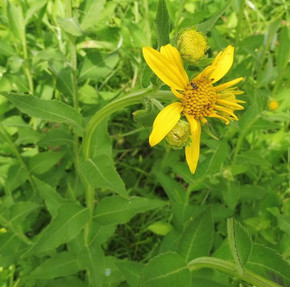
Heliopsis helianthoides - FALSE SUNFLOWER (OX EYE)
Easy to grow, forgiving, long-flowering perennial, very valuable for many native insects, several butterflies and skippers and small birds. Tough and longer-lived.
Stays in clumps, and has coarse leaves
Blooming Time: June to August
Size: 3' tall x 1.5-2' wide
USDA Zones: Suitable for zones 3 to 9
Culture: Full sun, half sun, half shade, up to very light shade. average soil, adaptable to many soil types, including clay or rocky soil.
Moisture Needs: average moisture to slightly moist
Origin:Native to eastern and central USA and some southern states, see the BONAP distribution map. Naturally occurs in many types of prairies and prairie remnants, savannas, open woodlands, grassy meadows in wooded areas, open woodlands, woodland edges etc.
Black Walnut Tolerant: yes
Deer/Rabbit Resistant: Deer may browse on the young sprouts, but avoids coarse thick mature leaves.
Attracts Butterflies or Pollinators: Valuable plant that attracts wide variety of insects - many native bees (bumblebees, little carpenter bees, digger bees, cuckoo bees, leaf-cutting bees, Halictid bees, Andrenid bees), several species of wasps, bee flies, beetles, butterflies and skippers.
Attracts Hummingbirds: No, but small songbirds can feed on the seeds.
Pot Size: square 3.5" x 4" deep perennial pot
Plant Combinations: Excellent plant for the transition areas in your garden (with some sun and some shade during the day) or for sunny bed or woodland edge. Due to its adaptability, it can be combined with typical border or more natural perennials like Asclepias tuberosa, Agastache, Chrysanthemum, Echinacea, Echinops, Eupatorium, Geranium 'Rozanne', Helenium, Liatris, Lupinus, Monarda, Penstemon digitalis, Perovskia, Phlox, Rudbeckia, Salvia nemorosa, Sedum telephium (Sedum x hybridum), Veronicastrum, Vernonia, etc.
This is a very good companion to the most popular perennials in the USA - the bearded Iris, Siberian iris and daylilies (Hemerocallis). It will also look good with taller or tall grasses like Andropogon gerardii, Panicum virgatum (switch grass), Schizachyrium scoparium, Sporobolus heterolepis, Pennisetum, or summer flowering shrubs like Hydrangea paniculata.
Great cut flower!
Picture copyright : Wilhelm Zimmerling PAR, Commons Wikipedia

Heliopsis helianthoides - FALSE SUNFLOWER (OX EYE)
Easy to grow, forgiving, long-flowering perennial, very valuable for many native insects, several butterflies and skippers and small birds. Tough and longer-lived.
Stays in clumps, and has coarse leaves
Blooming Time: June to August
Size: 3' tall x 1.5-2' wide
USDA Zones: Suitable for zones 3 to 9
Culture: Full sun, half sun, half shade, up to very light shade. average soil, adaptable to many soil types, including clay or rocky soil.
Moisture Needs: average moisture to slightly moist
Origin:Native to eastern and central USA and some southern states, see the BONAP distribution map. Naturally occurs in many types of prairies and prairie remnants, savannas, open woodlands, grassy meadows in wooded areas, open woodlands, woodland edges etc.
Black Walnut Tolerant: yes
Deer/Rabbit Resistant: Deer may browse on the young sprouts, but avoids coarse thick mature leaves.
Attracts Butterflies or Pollinators: Valuable plant that attracts wide variety of insects - many native bees (bumblebees, little carpenter bees, digger bees, cuckoo bees, leaf-cutting bees, Halictid bees, Andrenid bees), several species of wasps, bee flies, beetles, butterflies and skippers.
Attracts Hummingbirds: No, but small songbirds can feed on the seeds.
Pot Size: square 3.5" x 4" deep perennial pot
Plant Combinations: Excellent plant for the transition areas in your garden (with some sun and some shade during the day) or for sunny bed or woodland edge. Due to its adaptability, it can be combined with typical border or more natural perennials like Asclepias tuberosa, Agastache, Chrysanthemum, Echinacea, Echinops, Eupatorium, Geranium 'Rozanne', Helenium, Liatris, Lupinus, Monarda, Penstemon digitalis, Perovskia, Phlox, Rudbeckia, Salvia nemorosa, Sedum telephium (Sedum x hybridum), Veronicastrum, Vernonia, etc.
This is a very good companion to the most popular perennials in the USA - the bearded Iris, Siberian iris and daylilies (Hemerocallis). It will also look good with taller or tall grasses like Andropogon gerardii, Panicum virgatum (switch grass), Schizachyrium scoparium, Sporobolus heterolepis, Pennisetum, or summer flowering shrubs like Hydrangea paniculata.
Great cut flower!
Picture copyright : Wilhelm Zimmerling PAR, Commons Wikipedia
Customer Reviews
-
False sunflower
The plants arrived in healthy condition. The roots were severely pot bound. It was easily remedied by slicing the bottom of the root ball, scoring its sides and teasing out its roots.
-
False sunflower
Great plant! I bought 3 of these plants last year and was amazed by the long period of flowering through the summer. The plants came back this spring looking even stronger. They do spread and each plant took up an area about 1 ft X 4 ft. I purchased two more for the back of my property. Mine are in full sun, loamy soil and tolerated the dry summer last year with weekly watering.





